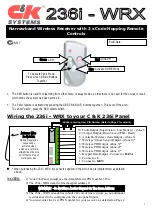
Page 6
SPEAKER
IMPEDANCE
/ OHMS
SPEAKER
LOAD
SELECTOR
4 ~ 6
8 ~ 16
LOW
HIGH
+
–
+
–
RIGHT
LEFT
1
2
1
2
SPEAKER
LOAD
SELECTOR
FRONT SPEAKERS
LOW HIGH
RIGHT
1
RIGHT
1
RIGHT
1
Connecting the Speakers
You can connect the following speakers:
• Two pairs of front speakers to produce normal stereo sound.
• One pair of rear speakers to enjoy the surround effect.
• One center speaker to produce more effective surround effect (to emphasize human voices).
• One subwoofer to enhance the bass.
For each speaker (except for subwoofer), connect the black (–) and red (+) terminals on the rear panel to the
black (–) and red (+) terminals marked on the speakers. For connecting a subwoofer, see page 7.
CAUTION:
Use speakers with the SPEAKER IMPEDANCE indicated by the speaker terminals.
Connecting the front speakers
Cut, twist and remove the insulation at the end of each speaker signal cable first, and then, connect the front
speakers to the FRONT SPEAKERS terminals by using the cables.
You can connect two pairs of front speakers (one pair to the FRONT SPEAKERS
1
terminals, and another
pair to the FRONT SPEAKERS
2
terminals).
Right Speaker
Left Speaker
1
Turn the knob
counterclockwise.
2
Insert the speaker
signal cable.
3
Turn the knob
clockwise.
Notes:
• To obtain the best possible output power from the receiver, and to prevent the receiver from
being overheated, the receiver has the SPEAKER LOAD SELECTOR which should be set to
match the impedance of the connected speakers.
Set this selector according to the indications by the FRONT SPEAKERS terminals.
• When you connect two pairs of the speakers to the FRONT SPEAKERS terminals, use the
speakers having the impedance within the same range.
RX-772VBK[J]_0052-001A.En.01-23
97.4.8, 3:23 PM
6










































